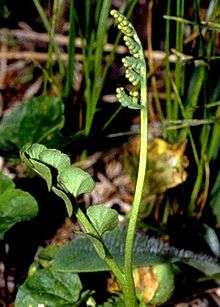Ophioglossales
| Ophioglossales | |
|---|---|
 | |
| Botrychium lunaria | |
| Scientific classification | |
| Kingdom: | Plantae |
| Division: | Pteridophyta |
| Class: | Psilotopsida |
| Order: | Ophioglossales Link |
| Families and Genera | |
| |
Ophioglossales (lit. 'snake-tongue [plants]') are a small group of pteridophyte plants. Traditionally they are included in the division Pteridophyta, the ferns, originally as a family and later as the order Ophioglossales. In some classifications this group is placed in a separate division, the Ophioglossophyta, but recent molecular systematic studies have shown the Ophioglossales to be closely related to the Psilotales.
In the molecular phylogenetic classification of Smith et al. in 2006, Ophioglossales, in its present circumscription, was placed with the order Psilotales in the class Psilotopsida.[1] The linear sequence of Christenhusz et al. (2011), intended for compatibility with the classification of Chase and Reveal (2009)[2] which placed all land plants in Equisetopsida,[3] made it a member of subclass Ophioglossidae, equivalent to Smith's Psilotopsida.[2] The placement of Ophioglossales in subclass Ophioglossidae has subsequently been followed in the classifications of Christenhusz and Chase (2014)[4] and PPG I (2016).[5]
Older treatments have recognized segregate families within Ophioglossales such as Botrychiaceae for the moonworts and grape ferns and Helminthostachyaceae for Helminthostachys, but all modern treatments combine all members of the order into the single family Ophioglossaceae.[1][2][4][5]
The plants have short-lived spores formed in sporangia lacking an annulus, and borne on a stalk that splits from the leaf blade; and fleshy roots. Many species only send up one frond or leaf-blade per year. A few species send up the fertile spikes only, without any conventional leaf-blade. The gametophytes are subterranean. The spores will not germinate if exposed to sunlight, and the gametophyte can live some two decades without forming a sporophyte.
The genus Ophioglossum has the highest chromosome counts of any known plant. The record holder is Ophioglossum reticulatum, with about 630 pairs of chromosomes (1260 chromosomes per cell).[6]
References and external links
- 1 2 Smith, Alan R.; Pryer, Kathleen M.; Schuettpelz, Eric; Korall, Petra; Schneider, Harald; Wolf, Paul G. (August 2006). "A classification for extant ferns" (PDF). Taxon. 55 (3): 705–731. doi:10.2307/25065646.
- 1 2 3 Christenhusz, Maarten J. M.; Zhang, Xian-Chun; Schneider, Harald (18 February 2011). "A linear sequence of extant families and genera of lycophytes and ferns" (PDF). Phytotaxa. 19: 7–54.
- ↑ Chase, Mark W.; Reveal, James L. (October 2009). "A phylogenetic classification of the land plants to accompany APG III". Botanical Journal of the Linnean Society. 161 (2). doi:10.1111/j.1095-8339.2009.01002.x.
- 1 2 Christenhusz, Maarten J. M.; Chase, Mark W. (13 February 2014). "Trends and concepts in fern classification". Annals of Botany. 113 (4): 571–594. doi:10.1093/aob/mct299. PMC 3936591.
- 1 2 The Pteridophyte Phylogeny Group (November 2016). "A community-derived classification for extant lycophytes and ferns". Journal of Systematics and Evolution. 54 (6): 563–603. doi:10.1111/jse.12229.
- ↑ Raven, Peter H., Ray F. Evert, & Susan E. Eichhorn, 2005. Biology of Plants, 7th edition. (New York: W. H. Freeman and Company). ISBN 0-7167-1007-2.